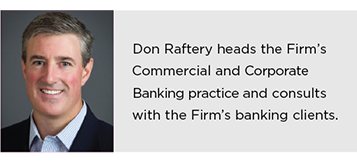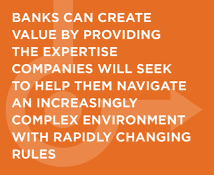Table of Contents
- 1.Onerous C.A.R.L. (Compliance, Audit, Risk, and Legal) costs abate
- 2.Banks accelerate transformation into tech companies
- 3.Banks get more disciplined in resource allocation
- 4.Rising battle for banker talent
- 5."Artificial intelligence" takes transformtional steps
- 6.Blockchain moves past hype to "use cases" in niche pockets
- 7.Global banking doesn't shrink
- 8.Specialist providers win wallet from traditional banks
- 9.The fintech herd is culled
- 10.Dominate digital brands emerge with foundations on security
- 11.Bonus Trend: Banks get "Minted" via open API

A combination of changes, including: rising interest rates, a less zealous regulatory environment, tax cuts, and overall optimism among business owners will provide a much-needed profit boost for banks. This in turn will help offset rapidly rising technology expenses and enable banks to accelerate transformative digitization of platforms and processes. In addition, significant advisory opportunities will benefit those bankers bold enough to help clients navigate these changes in 2017.
Here are 11 major trends to watch for in the coming year and beyond.
Onerous C.A.R.L. (Compliance, Audit, Risk, and Legal) costs abate
While few are expecting a near-term full repeal of Dodd-Frank, Greenwich Associates does expect to see a regulatory environment that is less zealous in enforcement and more measured in leveling fines.
This change will provide banks with the confidence to increase focus on client-facing activities. It will also allow banks to examine and potentially curtail some of the massive infrastructure and costs put in place over the last few years to address C.A.R.L.
Banks accelerate transformation into tech companies
Midsize and larger banks are making massive investments to transform their businesses into digital service providers. This transformative process is impacting not only legacy systems, but also decisions about which firms—including fintech vendors—they invest in, partner with, or purchase.
In the short term, banks that hesitate from taking this leap could get a bump from underinvesting in technology and maintaining a strong traditional franchise. However, at some point in the near future they will not have the wherewithal to effectively and successfully compete in key segments without digital competencies.
As it evolves into more of a tech industry, banking will become a scale business in which the largest providers will be able to invest in solutions that will differentiate their client experience. On the flip side, since scale is often the enemy
of nimble innovation, partnering with and/or purchasing fintech firms will be an important part of the strategy.
Long term, banks without legacy overhangs of branch networks and heavy ties to paper-based processing will be advantaged, as those assets will be increasingly less valued.
Banks get more disciplined in resource allocation
Banks will become more comfortable operating in the cost-contained environments needed to fund investments in digital transformation. As a result, resource allocation will shift to more disciplined and quantitative assessments of market opportunities for growth.
“Juniorization” of staffing models and low-touch delivery channels for “lower value” clients will be the norm. Only “high value” clients will command the best and brightest resources.
Resources freed up through these changes will be focused on new business development activities inside the most attractive prospects by geography, revenue potential/wallet size, likely growth, etc. New market and account opportunity analytical tools will help target and pinpoint opportunities by wallet size and potential.
Rising battle for banker talent
The war for banker talent will become fierce. Highly skilled advisors that help clients through uncertain times with complex solutions will become more difficult to find and retain.
Most leading banks are shifting their strategies to have bankers take on a substantially more advisory role with clients. They are looking for bankers able to consistently execute on being a trusted advisor to client senior management teams while also selling the full product solution set. There are plenty of bankers available in the market, but far too few with this advisory skill set.
During the financial crisis, most banks stopped their banker training programs. When the programs resumed, they were generally much smaller in scope and scale. On average, it takes 10+ years to train a banker to become highly effective and efficient in executing on an advisory model. We are entering a period where demand will outstrip supply for such highly talented advisors.
"Artificial intelligence" takes transformtional steps
Artificial Intelligence (AI) will evolve from a buzzword to a critical capability that helps drive better outcomes for clients (e.g., advice tailored to their specific and complex needs), increases efficiency for banks, and solves for talent shortfalls in banker advisory skills. AI, already at work in our living rooms (Alexa), phones (Siri), investment portfolios (robo-advising), and back office (chatbots) will be rapidly deployed across banking’s front lines over the next 24 months. These will be primarily first- and second-generation interfaces used to stimulate needs-based discussions with clients.
Next-generation advisory models being developed by leading banks will leverage AI interfaces that assess a large number of complex data sets including: econometrics, industry trends, peer analyses, foreign and domestic tax rates, bank fees, FX, interest rates, cash-flow cycles/seasonality, liquidity needs, costs of capital, etc. These data sets are mapped against the client’s current, short-, medium-, and long-term needs to create highly tailored advice.
While low-value clients may receive digital self-service AI advisory interfaces, higher-value clients will still be relationship managed. RMs will benefit from the efficiencies of AI algorithms doing much of the heavy analytical work.
Blockchain moves past hype to "use cases" in niche pockets
Blockchain is moving from prophetic transformational hype 18-24 months ago to a medium-term reality. Many banks have blockchain prototypes up and running in their innovation labs. Nevertheless, most major providers believe there will not be large and ample volumes of corporate cash management for at least the next 2-5 years.
This conclusion is based on recent interviews with 35 heads of global cash management at leading banks. These professionals expect to see initial use cases for blockchain/distributed ledger technology in internal bank processes (where visibility of transactions is less of an issue), bank-to-bank, transactions, and trade finance.
Global banking doesn't shrink
Companies will look for expertise to help them navigate an increasingly complex environment with rapidly changing rules.
Brexit, Trump’s potential trade tariffs, and upcoming European elections fueled by nationalistic sentiment all lead to greater complexity in conducting international business. Clients will need expert advice to help avoid potential pitfalls and optimize their decisions. Banks can create value based on this uncertainty and ultimately get paid for it through greater share of wallet and pricing.
Specialist providers win wallet from traditional banks
The rise of the specialist providers is happening today and will continue for the next several years, especially in peripheral products (401(k), wealth, merchant services, M&A, etc.). Specialists are generally easier to do business with and often have better pricing, service and/or product capabilities.
These non-traditional competitors will continue to encroach until banks: 1) effectively leverage the data available to them, 2) make doing business across the broad product array easier than choosing one-off best practice providers, and 3) ensure that bankers are properly trained and incented to cross-sell beyond the current product silos.
To compete against specialist providers, banks will purchase, license or develop their own smart analytics to suggest appropriate solutions, leverage known data to prepopulate/streamline applications/new product set-ups, and wrap it all together with easy-to-use integrated dashboard analytics.
The fintech herd is culled
Sky-high multiples for fintechs will be seen less often, as it becomes clear most need banks as partners to scale quickly enough to compete. A host of other factors will diminish fintech clout, including cash burn, PE firm backers’ appetite for regulatory pain, and their need to partner in order to obtain clients.
The balance of power will shift, with fintechs aggressively seeking out bank partners the same way banks were aggressively courting fintechs not long ago.
Dominate digital brands emerge with foundations on security
Increasingly sophisticated hacking and fraud schemes force companies to manage their exposure by limiting the number of financial services partners that have access to sensitive information flows. Many financial service providers will have significant and very public breaches that shake the confidence in their brands.
The leaders will have as key brand pillars: high platform security, easy-to-use interfaces and digital functionality that enables broad capabilities.
Bonus Trend: Banks get "Minted" via open API
The Revised Payment Service Directive (PSD2) is pushing banks in Europe to provide open application programming interfaces (APIs) that allow authorized account-level access to third parties. End users will benefit from the ability to aggregate data across multiple providers. Banks, meanwhile, face the risk that a fintech or other provider will become the front-end interface, relegating the financial service providers to commodity processors or utilities.
In the consumer space, Mint does a good job of account aggregation across providers. For many of its clients, it becomes the sole front-end digital-user experience—”owning the customer interface”. Mint sees the information and therefore has the opportunity to understand customer needs, suggest new products, and provide advice.
Just as mom-and-pop stores have been “Amazoned” for the past decade, watch for banks to get “Minted.”


